Arash Asadi
Embedded Systems Group, Delft University of Technology, 2628 CD Delft, Netherlands
Learning-Based Phase Shift Optimization of Liquid Crystal RIS in Dynamic mmWave Networks
Dec 17, 2025Abstract:To enhance coverage and signal quality in millimeter-wave (mmWave) frequencies, reconfigurable intelligent surfaces (RISs) have emerged as a game-changing solution to manipulate the wireless environment. Traditional semiconductor-based RISs face scalability issues due to high power consumption. Meanwhile, liquid crystal-based RISs (LC-RISs) offer energy-efficient and cost-effective operation even for large arrays. However, this promise has a caveat. LC-RISs suffer from long reconfiguration times, on the order of tens of milliseconds, which limits their applicability in dynamic scenarios. To date, prior works have focused on hardware design aspects or static scenarios to address this limitation, but little attention has been paid to optimization solutions for dynamic settings. Our paper fills this gap by proposing a reinforcement learning-based optimization framework to dynamically control the phase shifts of LC-RISs and maximize the data rate of a moving user. Specifically, we propose a Deep Deterministic Policy Gradient (DDPG) algorithm that adapts the LC-RIS phase shifts without requiring perfect channel state information and balances the tradeoff between signal-to-noise ratio (SNR) and configuration time. We validate our approach through high-fidelity ray tracing simulations, leveraging measurement data from an LC-RIS prototype. Our results demonstrate the potential of our solution to bring adaptive control to dynamic LC-RIS-assisted mmWave systems.
Faulty RIS-aided Integrated Sensing and Communication: Modeling and Optimization
May 23, 2025Abstract:This work investigates a practical reconfigurable intelligent surface (RIS)-aided integrated sensing and communication (ISAC) system, where a subset of RIS elements fail to function properly and reflect incident signals randomly towards unintended directions, thereby degrading system performance. To date, no study has addressed such impairments caused by faulty RIS elements in ISAC systems. This work aims to fill the gap. First, to quantify the impact of faulty elements on ISAC performance, we derive the misspecified Cram\'er-Rao bound (MCRB) for sensing parameter estimation and signal-to-interference-and-noise ratio (SINR) for communication quality. Then, to mitigate the performance loss caused by faulty elements, we jointly design the remaining functional RIS phase shifts and transmit beamforming to minimize the MCRB, subject to the communication SINR and transmit power constraints. The resulting optimization problem is highly non-convex due to the intricate structure of the MCRB expression and constant-modulus constraint imposed on RIS. To address this, we reformulate it into a more tractable form and propose a block coordinate descent (BCD) algorithm that incorporates majorization-minimization (MM), successive convex approximation (SCA), and penalization techniques. Simulation results demonstrate that our proposed approach reduces the MCRB performance loss by 24.36% on average compared to the case where the presence of faulty elements is ignored. Furthermore, the performance gain becomes more evident as the number of faulty elements increases.
Temperature-Resilient LC-RIS Phase-Shift Design for Multi-user Downlink Communications
May 08, 2025Abstract:The reflecting antenna elements in most reconfigurable intelligent surfaces (RISs) use semiconductor-based (e.g., positive-intrinsic-negative (PIN) diodes and varactors) phase shifters. Although effective, a drawback of this technology is the high power consumption and cost, which become particularly prohibitive in millimeter-wave (mmWave)/sub-Terahertz range. With the advances in Liquid Crystals (LCs) in microwave engineering, we have observed a new trend in using LC for realizing phase shifter networks of RISs. LC-RISs are expected to significantly reduce the fabrication costs and power consumption. However, the nematic LC molecules are sensitive to temperature variations. Therefore, implementing LC-RIS in geographical regions with varying temperatures requires temperature-resilient designs. The mentioned temperature variation issue becomes more significant at higher temperatures as the phase shifter range reduces in warmer conditions, whereas it expands in cooler ones. In this paper, we study the impact of temperature on the operation of LC-RISs and develop a temperature-resilient phase shift design. Specifically, we formulate a max-min signal-to-interference-plus-noise ratio optimization for a multi-user downlink mmWave network that accounts for the impact of temperature in the LC-RIS phase shifts. The simulation results demonstrate a significant improvement for the considered set of parameters when using our algorithm compared to the baseline approach, which neglects the temperature effects.
Fast Reconfiguration of LC-RISs: Modeling and Algorithm Design
Apr 11, 2025Abstract:LC technology is a promising hardware solution for realizing extremely large RISs due to its advantages in cost-effectiveness, scalability, energy efficiency, and continuous phase shift tunability. However, the slow response time of the LC cells, especially in comparison to the silicon-based alternatives like radio frequency switches and PIN diodes, limits the performance. This limitation becomes particularly relevant in TDMA applications where RIS must sequentially serve users in different locations, as the phase-shifting response time of LC cells can constrain system performance. This paper addresses the slow phase-shifting limitation of LC by developing a physics-based model for the time response of an LC unit cell and proposing a novel phase-shift design framework to reduce the transition time. Specifically, exploiting the fact that LC-RIS at milimeter wave bands have a large electric aperture, we optimize the LC phase shifts based on user locations, eliminating the need for full channel state information and minimizing reconfiguration overhead. Moreover, instead of focusing on a single point, the RIS phase shifters are designed to optimize coverage over an area. This enhances communication reliability for mobile users and mitigates performance degradation due to user location estimation errors. The proposed design minimizes the transition time between configurations, a critical requirement for TDMA schemes. Our analysis reveals that the impact of RIS reconfiguration time on system throughput becomes particularly significant when TDMA intervals are comparable to the reconfiguration time. In such scenarios, optimizing the phase-shift design helps mitigate performance degradation while ensuring specific QoS requirements. Moreover, the proposed algorithm has been tested through experimental evaluations, which demonstrate that it also performs effectively in practice.
Temperature-Aware Phase-shift Design of LC-RIS for Secure Communication
Nov 19, 2024



Abstract:Liquid crystal (LC) technology enables low-power and cost-effective solutions for implementing the reconfigurable intelligent surface (RIS). However, the phase-shift response of LC-RISs is temperature-dependent, which, if unaddressed, can degrade the performance. This issue is particularly critical in applications such as secure communications, where variations in phase-shift response may lead to significant information leakage. In this paper, we consider secure communication through an LC-RIS and developed a temperature-aware algorithm adapting the RIS phase shifts to thermal conditions. Our simulation results demonstrate that the proposed algorithm significantly improves the secure data rate compared to scenarios where temperature variations are not accounted for.
LiquiRIS: A Major Step Towards Fast Beam Switching in Liquid Crystal-based RISs
Oct 28, 2024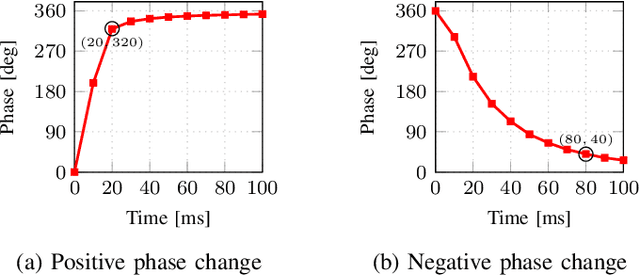
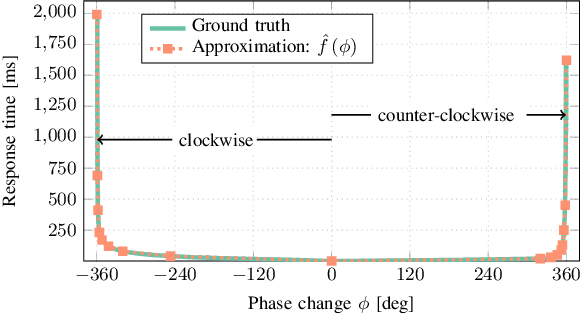
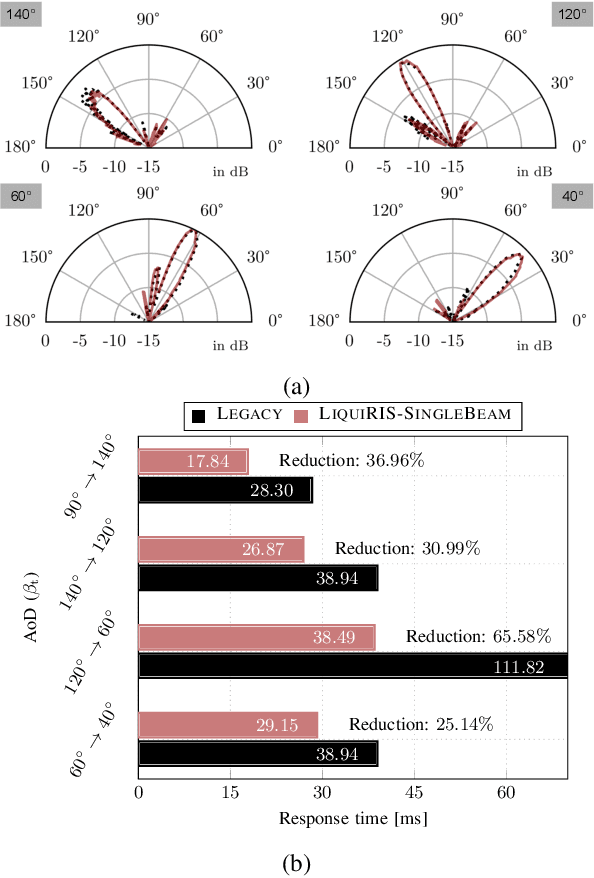
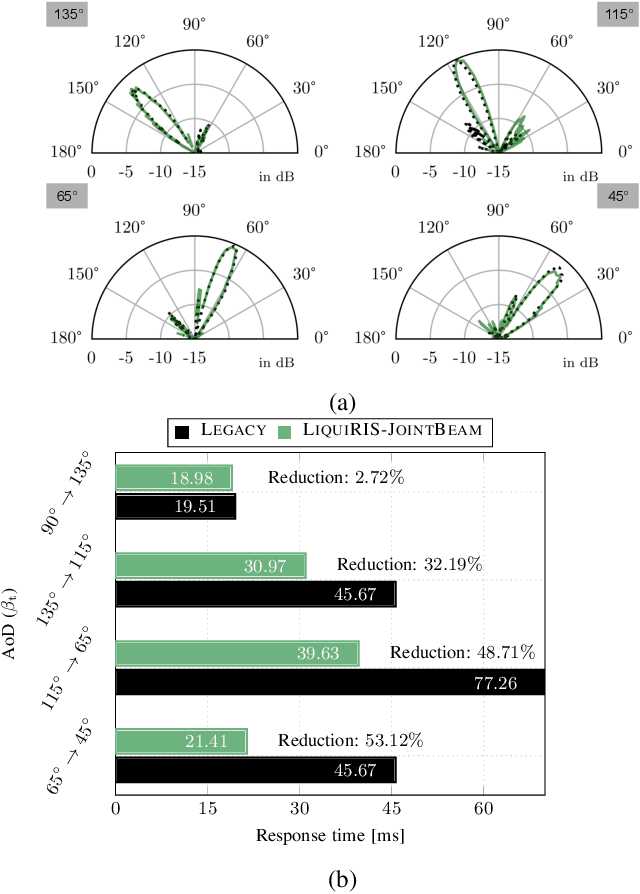
Abstract:Reconfigurable intelligent surfaces (RISs) offer enhanced control over propagation through phase and amplitude manipulation but face practical challenges like cost and power usage, especially at high frequencies. This is specifically a major problem at high frequencies (Ka- and V-band) where the high cost of semiconductor components (i.e., diodes, varactors, MEMSs) can make RISs prohibitively costly. In recent years, it is shown that liquid crystals (LCs) are low-cost and low-energy alternative which can address the aforementioned challenges but at the cost of lower response time. In LiquiRIS, we enable leveraging LC-based RIS in mobile networks. Specifically, we devise techniques that minimize the beam switching time of LC-based RIS by tapping into the physical properties of LCs and the underlying mathematical principles of beamforming. We achieve this by modeling and optimizing the beamforming vector to account for the rotation characteristics of LC molecules to reduce their transition time from one state to another. In addition to prototyping the proposed system, we show via extensive experimental analysis that LiquiRIS substantially reduces the response time (up to 70.80%) of liquid crystal surface (LCS).
Fast Transition-Aware Reconfiguration of Liquid Crystal-based RISs
Feb 08, 2024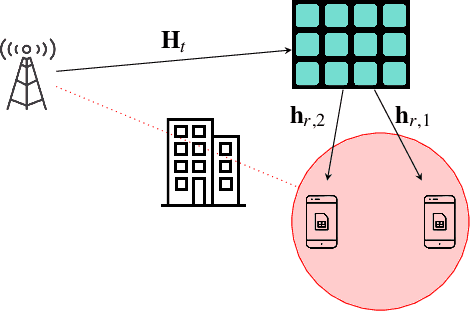
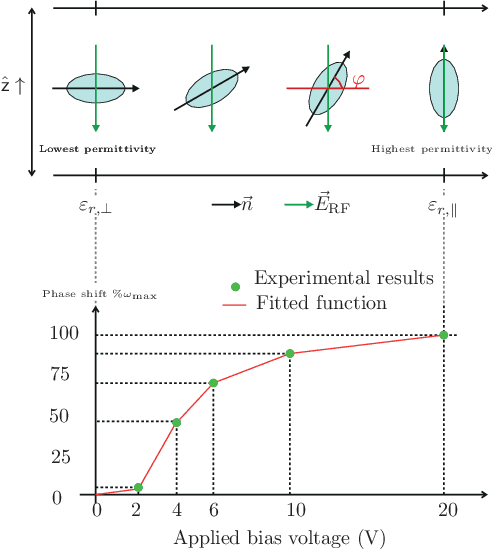
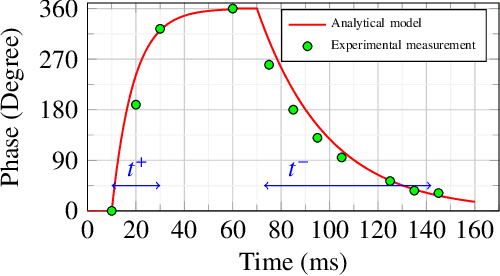

Abstract:Liquid crystal (LC) technology offers a cost-effective, scalable, energy-efficient, and continuous phase tunable realization of extremely large reconfigurable intelligent surfaces (RISs). However, LC response time to achieve a desired differential phase is significantly higher compared to competing silicon-based technologies (RF switches, PIN diodes, etc). The slow response time can be the performance bottleneck for applications where frequent reconfiguration of the RIS (e.g., to serve different users) is needed. In this paper, we develop an RIS phase-shift design that is aware of the transition behavior and aims to minimize the time to switch among multiple RIS configurations each serving a mobile user in a time-division multiple-access (TDMA) protocol. Our simulation results confirm that the proposed algorithm significantly reduces the time required for the users to achieve a threshold signal quality. This leads to a considerable improvement in the achievable throughput for applications, where the length of the TDMA time intervals is comparable with the RIS reconfiguration time.
BeamSec: A Practical mmWave Physical Layer Security Scheme Against Strong Adversaries
Sep 19, 2023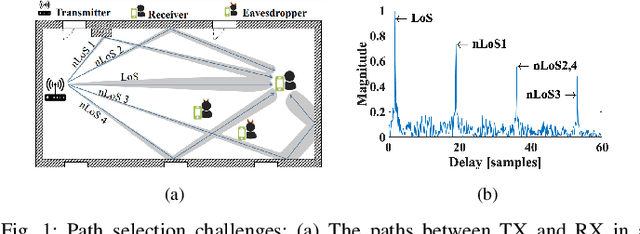
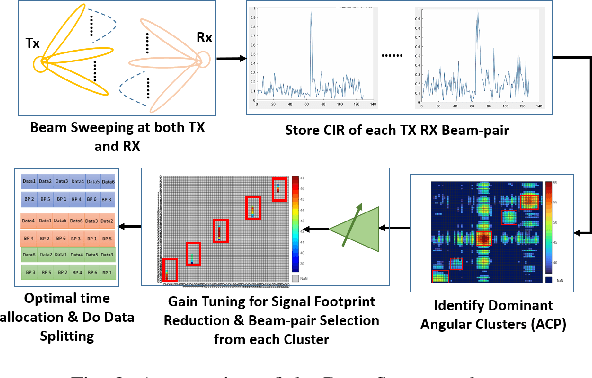
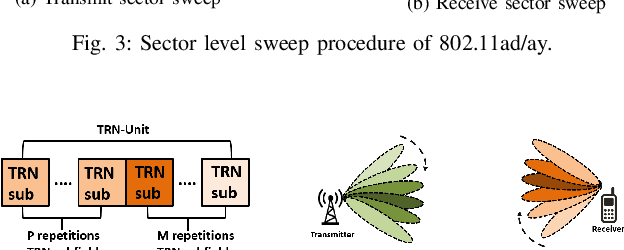
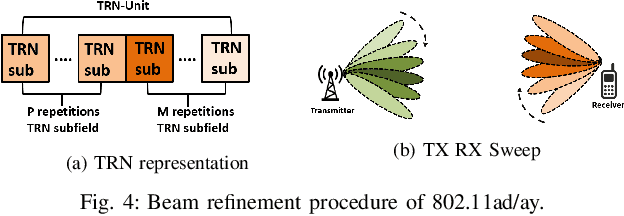
Abstract:The high directionality of millimeter-wave (mmWave) communication systems has proven effective in reducing the attack surface against eavesdropping, thus improving the physical layer security. However, even with highly directional beams, the system is still exposed to eavesdropping against adversaries located within the main lobe. In this paper, we propose \acrshort{BSec}, a solution to protect the users even from adversaries located in the main lobe. The key feature of BeamSec are: (i) Operating without the knowledge of eavesdropper's location/channel; (ii) Robustness against colluding eavesdropping attack and (iii) Standard compatibility, which we prove using experiments via our IEEE 802.11ad/ay-compatible 60 GHz phased-array testbed. Methodologically, BeamSec first identifies uncorrelated and diverse beam-pairs between the transmitter and receiver by analyzing signal characteristics available through standard-compliant procedures. Next, it encodes the information jointly over all selected beam-pairs to minimize information leakage. We study two methods for allocating transmission time among different beams, namely uniform allocation (no knowledge of the wireless channel) and optimal allocation for maximization of the secrecy rate (with partial knowledge of the wireless channel). Our experiments show that \acrshort{BSec} outperforms the benchmark schemes against single and colluding eavesdroppers and enhances the secrecy rate by 79.8% over a random paths selection benchmark.
Low-complexity hardware and algorithm for joint communication and sensing
Sep 13, 2023Abstract:Joint Communication and Sensing (JCAS) is foreseen as one very distinctive feature of the emerging 6G systems providing, in addition to fast end reliable communication, the ability to obtain an accurate perception of the physical environment. In this paper, we propose a JCAS algorithm that exploits a novel beamforming architecture, which features a combination of wideband analog and narrowband digital beamforming. This allows accurate estimation of Time of Arrival (ToA), exploiting the large bandwidth and Angle of Arrival (AoA), exploiting the high-rank digital beamforming. In our proposal, we separately estimate the ToA and AoA. The association between ToA and AoA is solved by acquiring multiple non-coherent frames and adding up the signal from each frame such that a specific component is combined coherently before the AoA estimation. Consequently, this removes the need to use 2D and 3D joint estimation methods, thus significantly lowering complexity. The resolution performance of the method is compared with that of 2D MUltiple SIgnal Classification (2D-MUSIC) algorithm, using a fully-digital wideband beamforming architecture. The results show that the proposed method can achieve performance similar to a fully-digital high-bandwidth system, while requiring a fraction of the total aggregate sampling rate and having much lower complexity.
Joint Communication and Sensing in RIS-enabled mmWave Networks
Oct 07, 2022
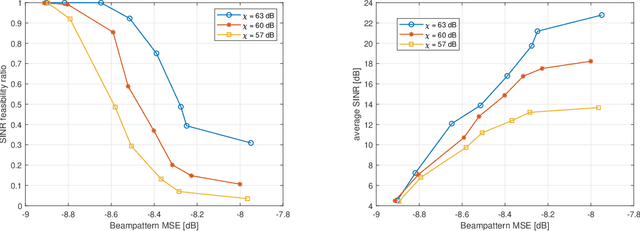
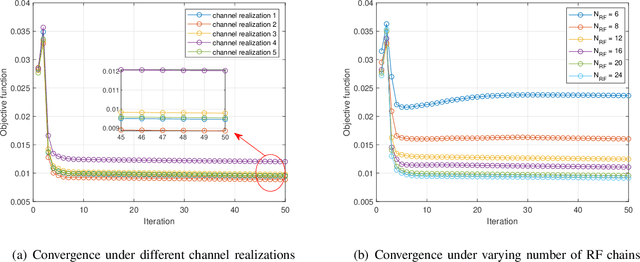
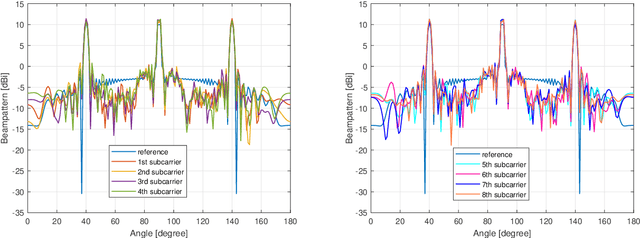
Abstract:Empowering cellular networks with augmented sensing capabilities is one of the key research areas in 6G communication systems. Recently, we have witnessed a plethora of efforts to devise solutions that integrate sensing capabilities into communication systems, i.e., joint communication and sensing (JCAS). However, most prior works do not consider the impact of reconfigurable intelligent surfaces (RISs) on JCAS systems, especially at millimeter-wave (mmWave) bands. Given that RISs are expected to become an integral part of cellular systems, it is important to investigate their potential in cellular networks beyond communication goals. In this paper, we study mmWave orthogonal frequency-division multiplexing (OFDM) JCAS systems in the presence of RISs. Specifically, we jointly design the hybrid beamforming and RIS phase shifts to guarantee the sensing functionalities via minimizing a chordal-distance metric, subject to signal-to-interference-plus-noise (SINR) and power constraints. The non-convexity of the investigated problem poses a challenge which we address by proposing a solution based on the penalty method and manifold-based alternating direction method of multipliers (ADMM). Simulation results demonstrate that under various settings both sensing and communication experience improved performance when the RIS is adequately designed. In addition, we discuss the tradeoff between sensing and communication.
 Add to Chrome
Add to Chrome Add to Firefox
Add to Firefox Add to Edge
Add to Edge